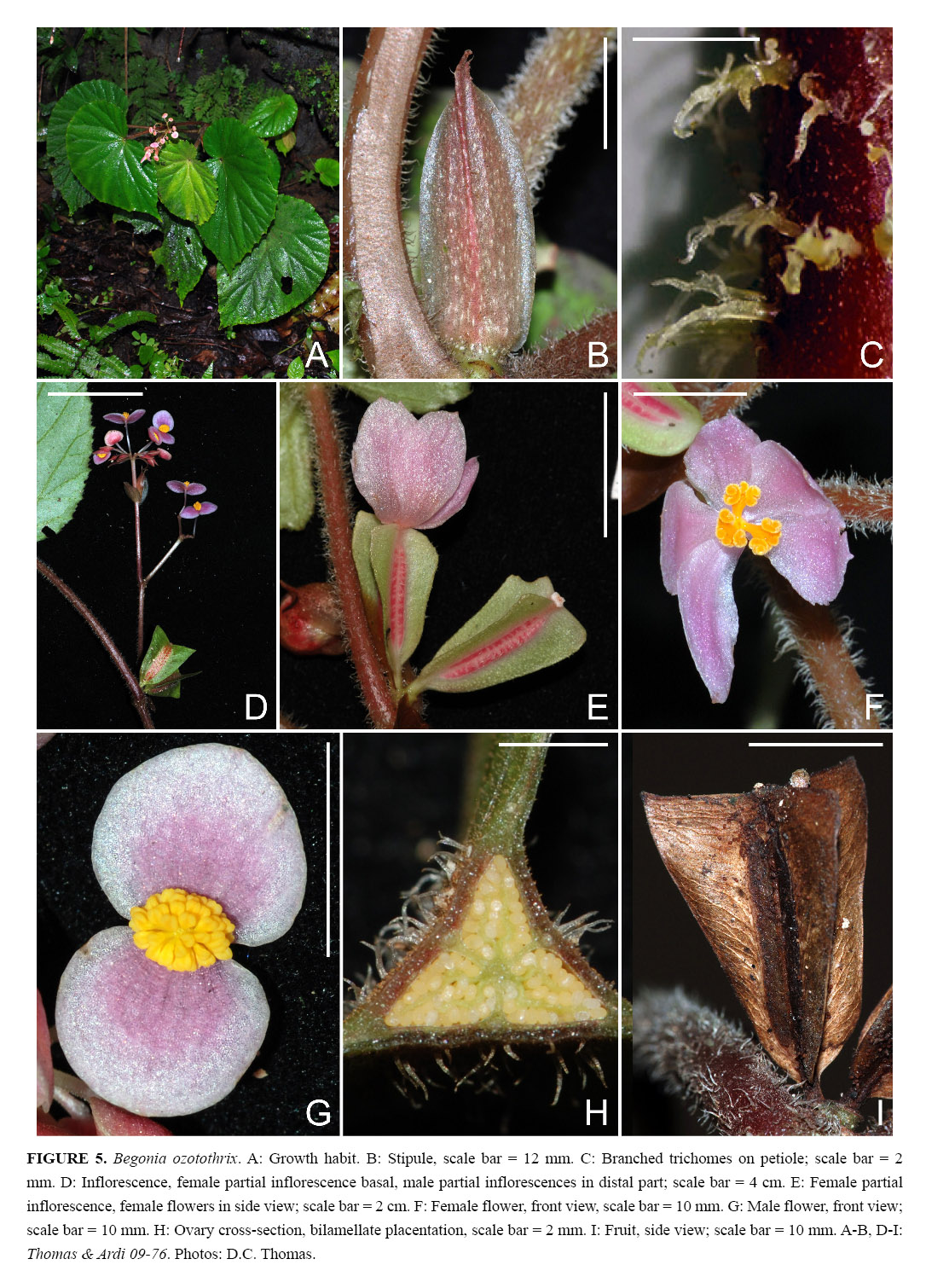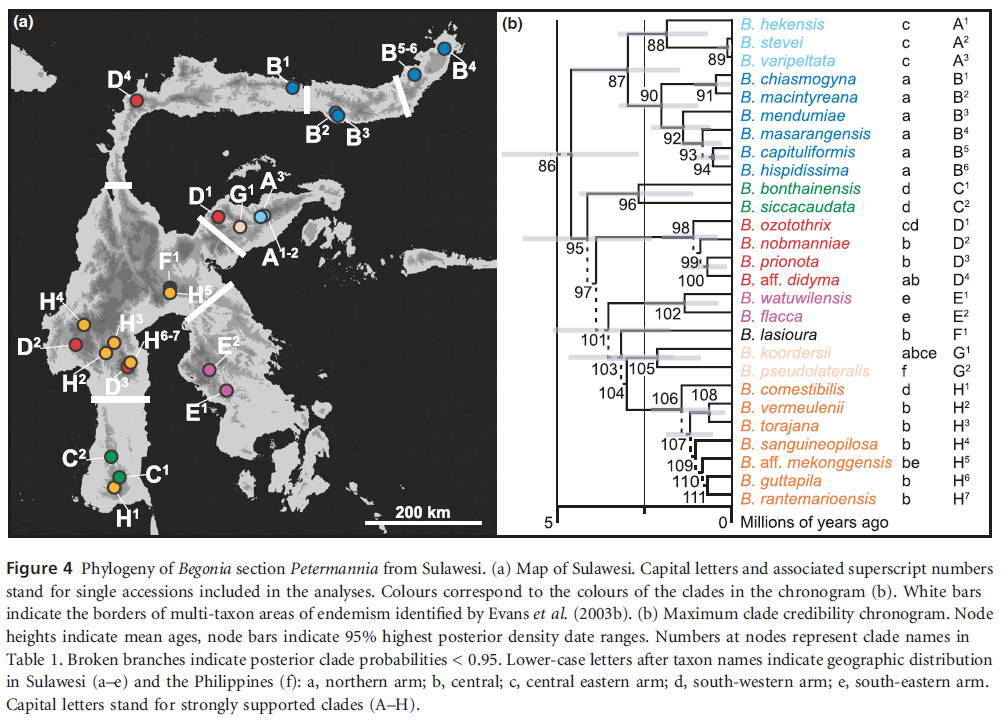Begonia ozotothrix in Edinburgh J. Bot. 66(1): 105. 2009
Primary tabs

Diagnosis
- Ab aliis speciebus sectionis Petermanniae in caule, petiolis et in laminae facie abaxiali pilos ramosos habenti differt. - Type: Indonesia, Sulawesi, Sulawesi Tengah, Tojo Una-una District, close to Watusongo Village, Gunung Katopas, on wet rock wall at riverbank, 01°10'17.9S, 121°28'40.5E, 615 m, 7 v 2008, D.C. Thomas & W.H. Ardi 08-67 (holo E; iso BO, CEB). (Thomas, D.C., Ardi, W.H. & Hughes, M. 2009: Two new species of Begonia (Begoniaceae) from Central Sulawesi, Indonesia. – Edinburgh Journal of Botany 66(1): 103-114)
Description
- Perennial, monoecious, erect herb, to 75cm tall, hairy with microscopic, c.0.05-0.2mm long, simple trichomes on all vegetative parts and heterotrichous on the stems, petioles and the veins of the abaxial lamina surface by the addition of a few interspersed multicellular, multiseriate, branched trichomes, c.0.3-1.8 mm long.
Stems branched; internodes 2.9-7.9 cm long, hairy.
Leaves alternate; stipules 20-32 × 6-20 mm, very asymmetric, oblong to narrowly elliptic, cymbiform with abaxially prominent midrib forming a thin, short appendage at the apex, persistent, abaxially densely hairy; petioles 4.1-18.6 cm long, hairy; lamina basifixed, 14.5-24.8 × 7.2-15.3 cm, very asymmetric, elliptic, base cordate with non- or only very slightly overlapping lobes, apex acuminate, margin dentate, the teeth bristle-pointed, adaxial and abaxial surface hairy, adaxial surface mid green and abaxial surface pale green, or adaxial surface dark green and abaxial surface reddish, venation palmate-pinnate.
Inflorescences protogynous; female inflorescences basal to male inflorescences or solitary, 2-flowered, subtending leaves foliose, peduncles 1-5 mm long, bracts (subtending the pedicels of the female flowers) 8-11 × 6-7 mm, ovate to elliptic, abaxially hairy; male inflorescences distal to one female inflorescence, composed of 1-5 strongly compressed, cymose-subumbellate partial inflorescences, subtending leaves bracteose, c.8-11 × 7-9 mm, elliptic, abaxially hairy, peduncles 2-25 mm, hairy, bracts of only the most basal dichotomous branching developed, 3-10 × 2-6 mm, elliptic, abaxially hairy, caducous, each partial inflorescence branching once dichotomously at the base, then 1-2 times dichasially and the lateral branches of the most distal dichasia branching (0-)1-4 times monochasially.
Male flowers: pedicels 2-15 mm, hairy; tepals 2, white or pink, 8-11 × 9-12 mm, broadly ovate, base slightly cordate or with convex margins, apex rounded, abaxially sparsely hairy to glabrescent; androecium of c.25-35 stamens, yellow, filaments c.0.4-1.6 mm long, slightly fused at the very base, unequal, longer in the middle of the androecium, anthers c.0.8-1.4 mm long, obovate, dehiscing through unilaterally positioned slits c.1/2 as long as the anther, connective not projecting.
Female flowers: pedicels 1-4 mm, hairy; tepals 5, unequal to subequal, the four larger ones ovate or elliptic, 9-14 × 7-9 mm, the innermost obovate or narrowly elliptic, 8-11 × 3-8 mm, white or pale pink, abaxially hairy; ovary 12-21 × 10-18 mm, locules 3, placentation axile, placentae bilamellate, wings 3, narrowly triangular, rounded at the base, widest at the apex, hairy, style fused only in the most basal part, 3-branched, each stylodium bifurcate in the stigmatic region, stigmatic surface a spirally twisted papillose band, the style and stylodia pale yellow, the stigma bands orange.
Fruits: capsules cylindric, 19-22 × 4-6 mm (without wings), on stout, erect, 1-4 mm long, hairy pedicels, dehiscent, splitting along the wing attachment, drying pale brown, hairy to glabrescent, wing shape as for ovary, wings 5-10 mm wide at the widest point (at the apex), hairy to glabrescent. Seeds ellipsoidal, c.0.3 mm long, collar cells c.1/2-3/4 of the length of the seed. (Thomas, D.C., Ardi, W.H. & Hughes, M. 2009: Two new species of Begonia (Begoniaceae) from Central Sulawesi, Indonesia. – Edinburgh Journal of Botany 66(1): 103-114)
Habitat
- This species grows in the herb layer or on wet rock walls in lowland and upland primary rainforest, often at the sides of rivers or small streams, between c.300 and 800 m.
- Forest floor, the base of limestone boulders, and wet rock walls or limestone cliffs in lowland to upland primary to strongly disturbed rainforest at ca. 200–800 m elevation. (Ardi, W.H., Chikmawati, T., Witono, J.R. & Thomas, D.C. (2018). A synopsis of Begonia (Begoniaceae) of Southeastern Sulawesi including four new species. Phytotaxa 381.1: 027-050.)
Conservation
- Proposed IUCN conservation category: LC. This species is locally common and more than 20 populations were observed along a c.40kmwalking trail between the villages of Bulan Jaya and Uwetangko, and the upland rainforest north of Uwetangko. Additionally, several populations were observed on Gunung Katopas. While the lowland rainforest area of this species is fragmented by plantations (cacao and others), most of the upland populations were found in areas which are very difficult to access and show no or only slight signs of anthropogenic disturbance by rattan collecting. (Thomas, D.C., Ardi, W.H. & Hughes, M. 2009: Two new species of Begonia (Begoniaceae) from Central Sulawesi, Indonesia. – Edinburgh Journal of Botany 66(1): 103-114)
- Least Concern (LC). Begonia ozotothrix is endemic to Sulawesi but relatively widespread on the island (EOO: 62,257 km2) occurring in primary to strongly disturbed lowland to upland limestone forest habitats. Its range includes the legally protected Bantimurung National Park in South Sulawesi. Consequently, it should be considered Least Concern (LC). (Ardi, W.H., Chikmawati, T., Witono, J.R. & Thomas, D.C. (2018). A synopsis of Begonia (Begoniaceae) of Southeastern Sulawesi including four new species. Phytotaxa 381.1: 027-050.)
Distribution
Asia-Tropical: Sulawesi (Sulawesi endemic)
Indonesia; endemic to Sulawesi. Relatively widespread on Sulawesi with collections and observations from Central Sulawesi (Mt. Katopas and Mt. Lumut), South Sulawesi (Enrekang District, Bantimurung National Park), and Southeast Sulawesi (Sikori village, Bombana District). (Ardi, W.H., Chikmawati, T., Witono, J.R. & Thomas, D.C. (2018). A synopsis of Begonia (Begoniaceae) of Southeastern Sulawesi including four new species. Phytotaxa 381.1: 027-050.)
See 'Specimens' tab for map of point distribution data of georeferenced specimens.
Etymology
- The epithet "ozotothrix"(from Greek ozotos - branched, and thrix - hair) refers to the very unusual branched, multicellular, multiseriate trichomes found on the stem, the petioles and the abaxial lamina surfaces of Begonia ozotothrix.
Notes
- Begonias with branched trichomes are rare outside of Africa and have not previously been reported for Begonia section Petermannia. Stellate hairs have been described in only two Asian sections, Begonia section Parvibegonia A.DC. (B. sinuata Wall. exMeisn.) and Begonia section Diploclinium (Lindl.) A.DC. (B. cladotricha M.Hughes). Begonia picta Sm. (Begonia section Diploclinium) has branched, flattened scale-like hairs on the capsules. Begonia calcicola Merr. and B. oxysperma A.DC. (both in Begonia section Diploclinium, although the latter is usually classified in the monotypic Begonia section Baryandra A.DC.) have hairs with a broad and flat stalk divided at the apex into few to several thinner branches on the vegetative parts (Doorenbos et al., 1998; Hughes, 2007).
The morphology of the male inflorescences of Begonia ozotothrix is noteworthy as they exhibit a strong reduction syndrome. The male inflorescence morphology predominantly found in Begonia section Petermannia is characterised by cymose-dichasial branching with only very few or no monochasial branchings in the most distal part, clearly developed axes, and small bracts usually subtending the lateral branches in the cymose inflorescence (Irmscher, 1914; Doorenbos et al., 1998). However, Irmscher (1914) has already indicated that there are several variations of this typical syndrome in the huge section Petermannia. In Begonia ozotothrix the axes are strongly compressed resulting in a subumbellate appearance of the cymose inflorescences, only the bracts subtending the peduncles and the bracts subtending the lateral branches of the basal dichotomous branchings of the male partial inflorescences are developed, and there are only one or sometimes two basal dichasial branchings and up to four distal monochasial branchings. Similar compressed subumbellate syndromes have been described for the Sulawesi endemics Begonia siccacaudata J.Door., which shows male partial inflorescences with only one basal dichasial branching and the end flower flanked by two monochasia (Doorenbos, 2000), and Begonia mendumiae M.Hughes, which shows male inflorescences with compressed monochasial partial inflorescences (Hughes, 2006). An analysis of herbarium material from Sulawesi (A, B, BM, BO, CEB, E, K, L and SING) shows that similar subumbellate male inflorescences are characteristic for several undescribed species from Sulawesi, and this reduction syndrome might represent a synapomorphy for several species derived from an endemic radiation on Sulawesi. However, phylogenetic analyses of morphological and/or molecular data are needed to test this hypothesis. (Thomas, D.C., Ardi, W.H. & Hughes, M. 2009: Two new species of Begonia (Begoniaceae) from Central Sulawesi, Indonesia. – Edinburgh Journal of Botany 66(1): 103-114) - Begonia ozotothrix is a very distinct species in Begonia sect. Petermannia due to its indumentum of branched trichomes on stems and petioles (see Thomas et al. 2009a; Ardi & Thomas, 2015). It was originally described based on specimens collected from Mt. Lumut and Mt. Katopasa (Balingara mountain range) in Central Sulawesi (Thomas et al. 2009a). Since then, it has been collected and observed in lowland limestone forest habitats in SouthSulawesi (Bantimurung National Park, see Thomas et al. 2011; Massenrempulu Enrekang Botanic Gardens, Bone Karst), and Southeast Sulawesi (Bombana District), indicating that it is widespread on Sulawesi. (Ardi, W.H., Chikmawati, T., Witono, J.R. & Thomas, D.C. (2018). A synopsis of Begonia (Begoniaceae) of Southeastern Sulawesi including four new species. Phytotaxa 381.1: 027-050.)
Molecular Systematics
- see Thomas et al., 2012 (Thomas, D.C., Hughes, M., Phutthai, T., Ardi, W.H., Rajbhandary, S., Rubite, R., Twyford, A.D. & Richardson, J.E. 2012: West to east dispersal and subsequent rapid diversification of the mega-diverse genus Begonia (Begoniaceae) in the Malesian archipelago. – Journal of Biogeography 39: 98-113)
- GenBank
 |


